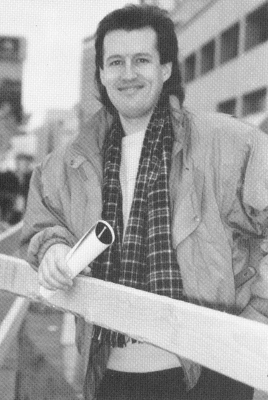 |
Page 7 Summer 1988
|
JW:
Describe for us the tricks you do in your current act. DF:
Well, I'll describe the technical part, but I'm not going to give
away the comedy bits. They're too difficult to conceive and too easy
to steal!
I
do three and four balls, and sometimes five and seven. My ring routine
includes five with a half-shower, a five-up pirouette, pancake
tosses and color changes. Then I do seven rings down to three and back
to seven, putting and taking them from under my arms and between my
legs.
Then
there's a picture trick with six hoops, a spinning ball on a
mouthstick and hoop on my leg. I do eight rings several times around,
starting with simultaneous tosses and breaking into alternate throws.
The
first part of the act establishes me as a good juggler, then I stick
in some goofy stuff - a nine ball gag and four connected cigar boxes.
The gags that have nothing to do with juggling usually get the biggest
reactions.
After
the rings, I do a three and four club routine I've been doing for
years. People applaud twice during it, then strongly at the end. I end
it with a kickup from four to five clubs with a couple of under the
leg throws and a pass-and-a-half of behind the back triples.
Now
I end the show with chain saws. They've been a good selling point in
American theatres, but wouldn't sell at all in Europe. I begin with
one, tossing it around my body. I cut a piece of wood to show everyone
it's real, then put it up into a chin balance. I purposely let it slip
off my chin and the audience gasps. Then I do the three.
JW:
What is your practice regimen? DF:
I really don't practice at all. Technically I get better just by
performing every day. I have better control of 7, 6 and 5 rings now
than ever before. I do spend 20 minutes warming up before each show,
and every once in a while I work a while afterward to keep my hands in
shape. I work on eight and nine some just to make my seven easier. I've
also got a pretty fair 10 ring juggle. It's taken a lot of work to get
it to where it is, and I'd like to maintain that.
I
still enjoy working out, but you've got to start worrying about your
elbows and aches and pains. After all, how many old Russian jugglers
do you see? They work so hard they get hurt and can't perform after a
few years. Where did Petrovski and Kiss go? On the other hand, Bela
Kremo juggled the year he died because he took care of himself.
I'm
working out a little now because I want to return to
JW:
Is the increased number of jugglers and exposure of the public to
juggling helping open markets for jugglers or just increasing
competition for established professionals like yourself? DF:
It has definitely opened up markets in advertising. But I think
it's mostly incidental to the main point of those commercials. Instead
of having someone jogging or break dancing, they're putting in
jugglers. The problem is that there's no quality there. The people who
see juggling in that forum don't know anything about good jugglers or
the IJA, they just think it's a neat thing to do.
I
reflect back on Art Jennings' article in
the last issue, and agree that the more quantity you have, the lower
the quality is. I think the American public is seeing less quality
juggling now. And what's good for commercials is bad for nightclubs.
There it creates more competition and brings the prices down. Suddenly
you've got 100 jugglers to pick from and a lot of them are doing the
same thing. The management hires the least expensive performer.
|
 |